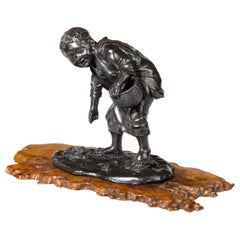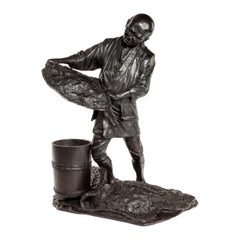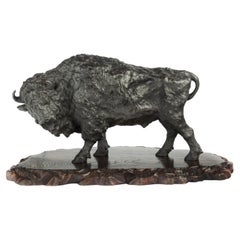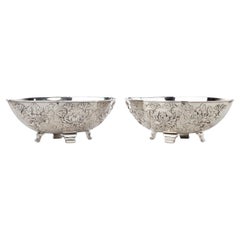Want more images or videos?
Request additional images or videos from the seller
1 of 11
19th Century Meiji Period Bronze of a Woodcutter Sawing a Large Tree Trunk
$5,855.31List Price
About the Item
- Dimensions:Height: 17 in (43.18 cm)Width: 13.5 in (34.29 cm)Length: 17 in (43.18 cm)
- Style:Meiji (Of the Period)
- Materials and Techniques:
- Place of Origin:
- Period:
- Date of Manufacture:1880
- Condition:Wear consistent with age and use.
- Seller Location:Lymington, GB
- Reference Number:1stDibs: LU973015872602
About the Seller
5.0
Recognized Seller
These prestigious sellers are industry leaders and represent the highest echelon for item quality and design.
Gold Seller
Premium sellers maintaining a 4.3+ rating and 24-hour response times
Established in 1982
1stDibs seller since 2013
135 sales on 1stDibs
Typical response time: 2 hours
Associations
LAPADA - The Association of Arts & Antiques Dealers
Authenticity Guarantee
In the unlikely event there’s an issue with an item’s authenticity, contact us within 1 year for a full refund. DetailsMoney-Back Guarantee
If your item is not as described, is damaged in transit, or does not arrive, contact us within 7 days for a full refund. Details24-Hour Cancellation
You have a 24-hour grace period in which to reconsider your purchase, with no questions asked.Vetted Professional Sellers
Our world-class sellers must adhere to strict standards for service and quality, maintaining the integrity of our listings.Price-Match Guarantee
If you find that a seller listed the same item for a lower price elsewhere, we’ll match it.Trusted Global Delivery
Our best-in-class carrier network provides specialized shipping options worldwide, including custom delivery.You May Also Like
19th Century 'Meiji Period' Japanese Bronze Vase
Located in North Miami, FL
19th Century (Meiji Period) Japanese bronze vase. It is realistically cast as a gnarled pine tree trunk with vines growing around it.
Category
Antique 19th Century Japanese Meiji Vases
Materials
Bronze
Large Burmese Bronze Medicine Buddha, Pagan Style, Late 19th Century
Located in Austin, TX
A large and magnificent cast bronze image of the Medicine Buddha, Bhaisajyaguru, rendered in the Burmese Pagan style, and most likely based on a period example that was either damaged or lost, 19th century, Burma or Thailand.
He can be identified as the Medicine Buddha by the hand that rests in his lap, with his middle finger touching the thumb. A medicine pot or fruit stem would originally have been placed in his upturned palm.
The face of this Buddha has been sculpted masterfully. He has a beautiful heart shaped face topped by hair neatly arranged in the typical "snail shell curls", and surmounted by a high ushnisha. Long, pendulous earlobes frame his face, a symbol of his princely past. He gazes serenely outwards from heavily lidded, downcast eyes, a content smile upon his full, lush lips.
The Buddha is portrayed seated in vajrasana (full lotus position), his elegant hands displayed in varada mudra, the gesture of granting favors and fulfilling wishes. Long, exquisite fingers extended, the thumb and middle finger touching in a gesture of compassion.
He is clothed in a simple kasaya wrapped around his body and over one shoulder, leaving the shoulder and part of his chest bare. The diaphanous garment clings to his body, outlining his well proportioned and graceful, almost sensuous, form. The excess material pooled in neat pleats in front of him. A sash thrown over his shoulder.
He sits upon a double lotus base upon a raised platform. The platform features two kneeling attendants, usually interpreted as the monks Ananda and Kasyapa. Between them is a circular disc representing the Wheel of Dharma. Contained in the disk is a flower with eight petals, symbolizing the eightfold path, one of the principle teachings of the Buddha.
The sides and back of the platform featuring a series of singha, or lions, representative of the Buddha's royal past.
An applied lacquer patina covers the entirety of the image. Large deposits of ash (from incense) are present between the curls of the hair, as well as some the other crevices, indicating this image was the subject of worship for many years.
Bhaisajyaguru, also called the Medicine Buddha, or Buddha of Healing, is a revered figure in the Buddhist pantheon as a master able to cure suffering, both physical and spiritual, through his teachings.
The Pagan Empire ruled most of present day Burma (Myanmar) from 849 to 1297. The capital, Bagan, served as a both the center of government and religion, where Buddhism reigned supreme. Bagan was also at a crossroads of the Buddhist world, with influence from India, Nepal, Tibet, China, and even Indonesia shaping their culture. As such, Pagan Buddha...
Category
Antique Late 19th Century Burmese Sculptures and Carvings
Materials
Bronze
$27,000
H 29 in W 24 in D 13.5 in
19th Century Gold Gilded Bronze Buddha
Located in Vero Beach, FL
19th century gold gilded bronze Buddha
A finely cast bronze Buddha statue in gold gilt with modeled and incised floral motifs. This jeweled God o...
Category
Antique 19th Century Chinese Qing Sculptures and Carvings
Materials
Bronze
Large 19th Century Chinese Carved Tea Caddy
Located in Atlanta, GA
Beautifully carved Qing dynasty tea caddy from Elmwood (yumu), with floral motifs. Beautiful original patina, the body is in a brown lacquer and the handle is finished with an red color lacquer. The large size is very usual and was used in a large family compound. The tea caddy is designed to hold and keep warm, large tea pot filled with tea. The tea pot’s spout comes out the front opening for pouring. The horizontal bar used as the container’s handle has a pivoting lock when open, the handle bar can be removed and closing of the pivoting lock, the handle is secure for use. The wooden tea caddy...
Category
Antique Late 19th Century Chinese Sculptures and Carvings
Materials
Elm
Large 19th Century Chinese Carved Tea Caddy
Located in Atlanta, GA
Beautifully carved Qing dynasty tea caddy from Elmwood (yumu), with floral motifs and finished with an oxblood color lacquer. The handle has a finely carved bat motif, which symbolizes good fortune. The large size is very usual and was used in a large family compound. The tea caddy is designed to hold and keep warm, large tea pot filled with tea. The tea pot’s spout comes out the front opening for pouring. The horizontal bar used as the container’s handle has a pivoting lock when open, the handle bar can be removed and closing of the pivoting lock, the handle is secure for use. The wooden tea caddy...
Category
Antique Late 19th Century Chinese Sculptures and Carvings
Materials
Elm
19th century Antique bronze Burmese Buddha statue from Burma
Located in DEVENTER, NL
This antique bronze Buddha statue is a truly unique and special collectible piece. Standing at 44.5 cm high, 23.6 cm wide and 13.5 cm deep, it is made of bronze and it weighs 8.93 kg...
Category
Antique 19th Century Burmese Sculptures and Carvings
Materials
Bronze
$3,238
Free Shipping
H 17.52 in W 9.3 in D 5.32 in
19th century Pair of two antique bronze Nepali Garuda statues from Nepal
Located in DEVENTER, NL
Pair of two antique bronze Nepali Garuda statues
Material : bronze
8,7 cm high
6,6 cm diameter
19th century (possibly earlier)
Weight: 784 grams
Originat...
Category
Antique 19th Century Nepalese Sculptures and Carvings
Materials
Bronze
$540
Free Shipping
H 3.43 in W 2.6 in D 2.6 in
Meiji Period Red and Black Painted Kimono Storage Box, Japan
Located in Point Richmond, CA
Japanese Kimono storage box, constructed of wood and bamboo, painted black with family crest painted in red on the sides. The top has wood slats, which ...
Category
20th Century Japanese Meiji Sculptures and Carvings
Materials
Wood
$600 Sale Price
20% Off
H 7 in W 31 in D 17 in
Large 19th century Chinese Carved Wooden Tea Caddy
Located in Atlanta, GA
Beautifully carved Qing dynasty tea caddy from Elmwood (yumu), with floral motifs and finished with an oxblood color lacquer. The large size is very usual and was used in a large family compound. The tea caddy is designed to hold and keep warm, large tea pot filled with tea. The tea pot’s spout comes out the front opening for pouring. The horizontal bar used as the container’s handle has a pivoting lock when open, the handle bar can be removed and closing of the pivoting lock, the handle is secure for use. The wooden tea caddy...
Category
Antique Late 19th Century Chinese Sculptures and Carvings
Materials
Elm
19th century Large Antique Burmese Throne from Burma
Located in DEVENTER, NL
Material : wood
201 cm high
128 cm wide and 92 cm deep
Gilded with 24 krt. gold
Mandalay style
19th century
Very special !
Can be shipped worldwide
Originating from Burma
Nr: 3688-18
Category
Antique 19th Century Burmese Sculptures and Carvings
Materials
Wood
$14,392
Free Shipping
H 79.14 in W 50.4 in D 36.23 in
More From This Seller
View All19th Century Meiji Period Bronze of a Boy Collecting Sweet Chestnuts by Seiya
Located in Lymington, Hampshire
A charming Meiji period bronze of a boy collecting sweet chestnuts by Seiya, he carries a basket and is looking down at an insect crawling over his hand, he is also evidently wearing...
Category
Antique 1880s Japanese Meiji Figurative Sculptures
Materials
Bronze
Meiji Period Bronze Sculpture of a Labourer
Located in Lymington, Hampshire
Unusual Meiji period bronze of a labourer sieving through a woven reed mat with another at his feet and a wooden bucket at his side, signed.
Category
Antique 1880s Japanese Sculptures and Carvings
Materials
Bronze
Large and Impressive Meiji Period Bronze Bison by Sano Takachika for the Kakuh
Located in Lymington, Hampshire
A large and impressive Meiji period bronze bison by Sano Takachika for the Kakuha Company, the animal powerfully modelled with his head low and turned s...
Category
Antique Early 1900s Japanese Meiji Sculptures and Carvings
Materials
Bronze
Pair of Meiji Period Solid Silver Bowls by Eigyoku
Located in Lymington, Hampshire
A pair of Meiji period solid silver bowls by Eigyoku, each of lobed oval form on four scroll feet, deeply embossed with continuous chrysanthemum hea...
Category
Vintage 1910s Japanese Meiji Metalwork
Materials
Silver
$26,452 / set
Chinese Paktong Basin, 19th Century
Located in Lymington, Hampshire
A Chinese paktong basin, engraved with scenes of many children at play and before pagodas, within borders of shou characters, bats and flowerheads, the flattened rim with vases of flowers and lingzhi, swords, lotus pods...
Category
Antique 19th Century Japanese Meiji Metalwork
Materials
Metal
19th Century Meiji Period Bronze Vase with Two Frogs
Located in Lymington, Hampshire
A Meiji period bronze vase with two frogs against a rough textured ground, signed ‘Hyakusei’, Japanese, circa 1880.
Category
Antique 1880s Japanese Meiji Metalwork
Materials
Bronze
Recently Viewed
View AllMore Ways To Browse
Ceremonial Asian Axe
Chinese Terracotta Army Warriors
Jade Geisha
Japanese Goban
Japanese Iki Doll
Maruki Japanese Bronze Boy
Mongolian Buddha
Owl Censer
Rai Stone
Rare Duck Decoys
Samurai Horse Bell
Whale Bone Cane
Willard Clark
Bone Foo Dogs
Mythical Creatures Thailand
Vintage Japanese Hakata Dolls
Hands Up Buddha
Horse Netsuke



